Jazz, the beating heart of The Primitif
By Dr Leah Cotterell, Letty Katts Fellow 2022 | 6 February 2024
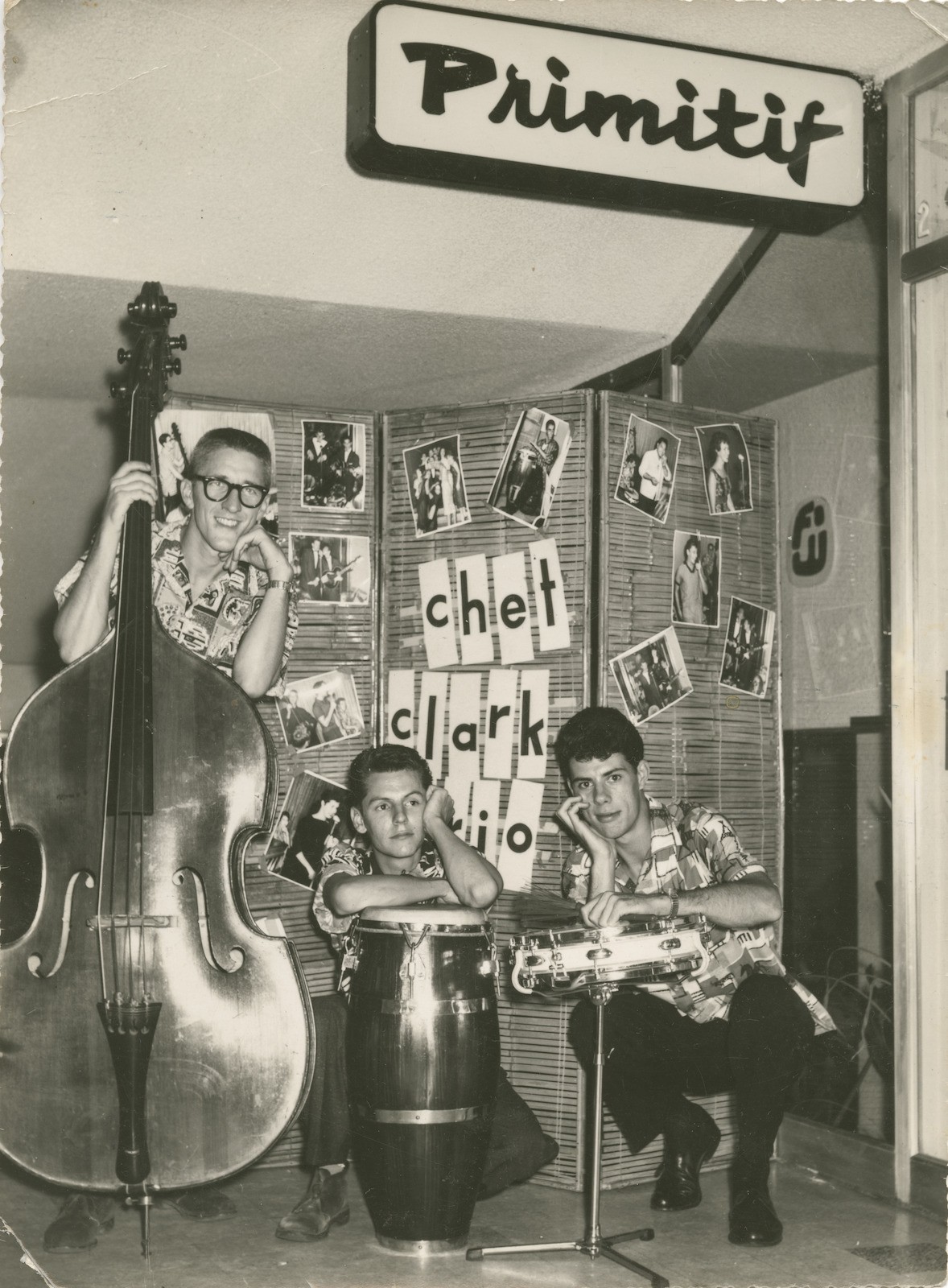
Chet Clark Trio at the Primitif Coffee Lounge, Brisbane. Kevin Anderson, photographer. 32929 Peter Hackworth photographs and ephemera. John Oxley Library, State Library of Queensland. Image number: 32929-0001-0008
This blog was written by 2022 Letty Katts Fellow, Dr Leah Cotterell.
Nearly two hundred photographs from The Primitif Coffee Lounge have been scanned into the collection of the State Library of Queensland. They show jazz musicians and variety entertainers performing at Sunday night gigs. They come from the personal collection of Peter Hackworth and were given to her by the photographer and Primitif cook, Kevin Anderson. The Primitif opened in 1957 and the photos were taken between 1957 and 1960.
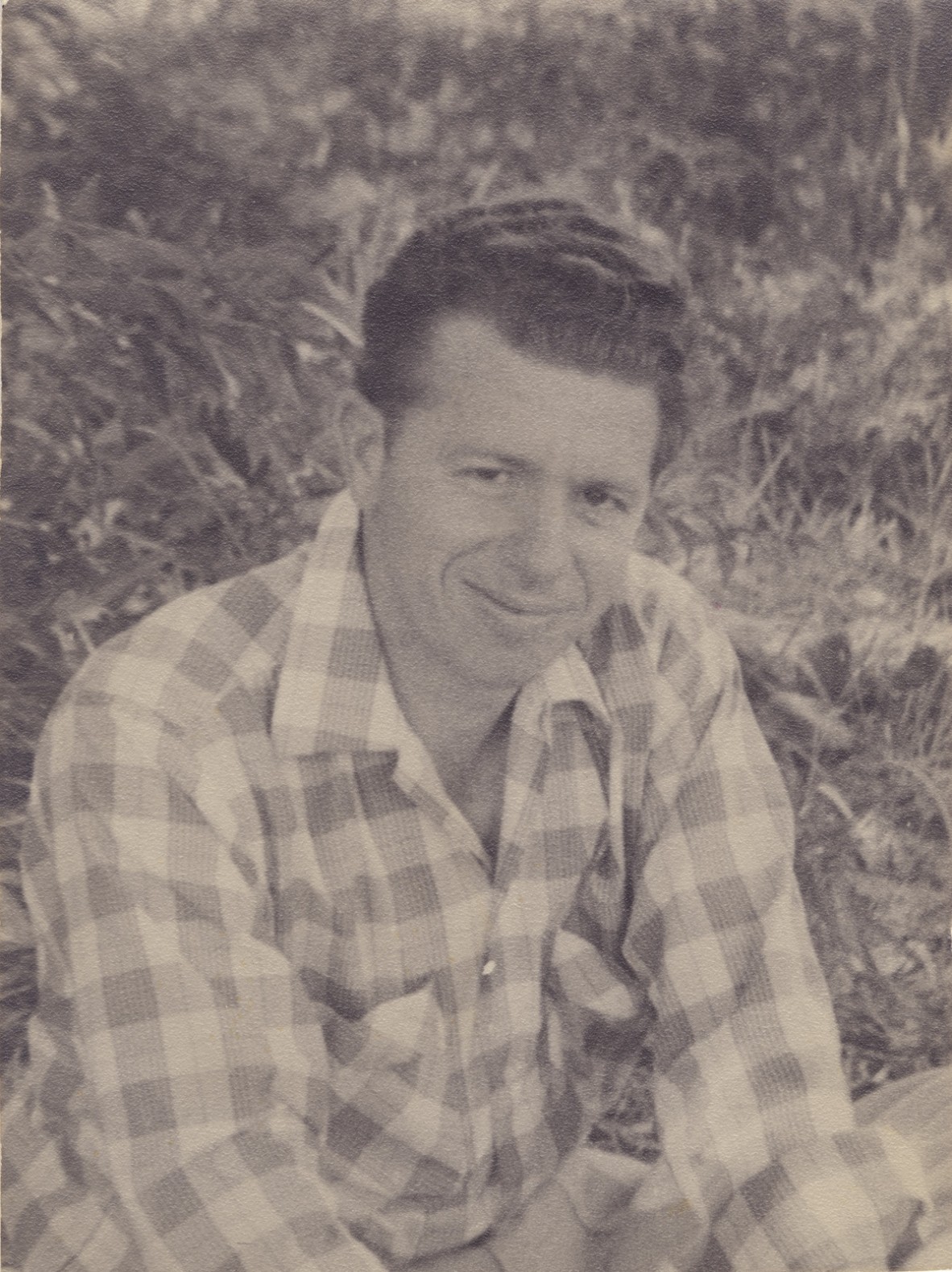
Photograph of Kevin Anderson (State Library of Queensland collection)
Kevin also took the promotional photograph of the first Primitif house band, the Chet Clark Trio (above). With their groovy Hawaiian shirts, Bill, Buzz and Chet are selling tropical cool. Chet and Buzz were both around 20 years old in this photo. Bill was probably some years older. Chet was already an experienced performer on piano, vibraphone, guitar and vocals while Buzz was establishing himself as a professional percussionist and drummer.
Unfortunately, I can’t tell you anything about Bill’s story (and I would be so glad if any reader could fill me in) but I’m going to draw on interviews with Buzz and online biographies of Chet to briefly describe how these two young men arrived at The Prim in 1957 and where they went afterwards. I’m particularly concerned with the contribution that live music makes to community and culture.
First of all I’ll try to put the music scene at The Primitif into context.
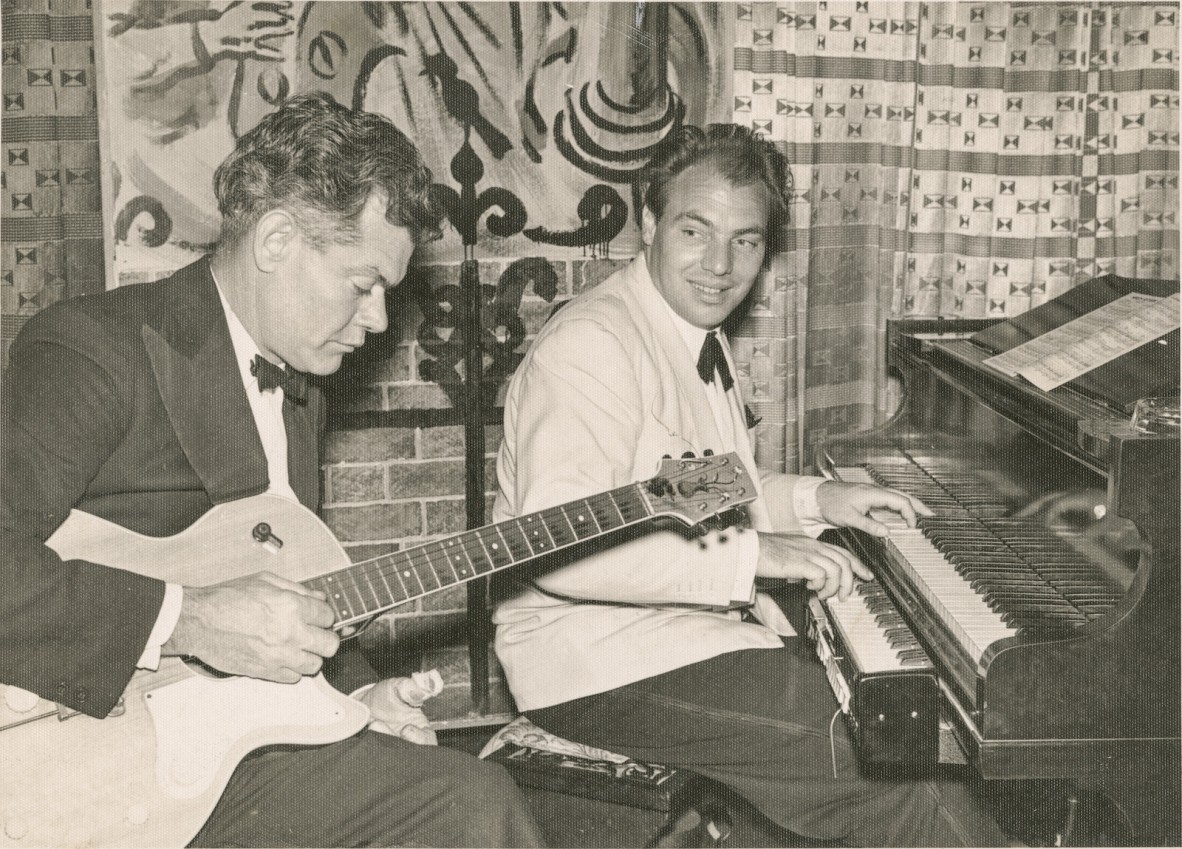
Guitarist, Darcy Kelly, performing at Le Boheme Nightclub, Brisbane. Kevin Anderson, photographer. 32929 Peter Hackworth photographs and ephemera. John Oxley Library, State Library of Queensland. Image number: 32929-0001-0234
Reviewing the 1957 entertainment listings in the Courier Mail and the Telegraph, there were a wide range of Brisbane venues serving mainstream tastes. Classical music concerts were presented by the Queensland Symphony Orchestra, chamber music was presented by Musica Viva, and special events at City Hall were presented by the ABC. In 1957 Lee Gordon presented five Big Show programs of American jazz and rock stars at the old Brisbane Stadium, soon to be demolished to make way for the new Festival Hall. Popular music in general was still influenced by swing band stylings suited to dancing, with big bands at Cloudland and the Ritz Ballroom[1], and small bands at many suburban halls and hotels. Amateur dancers, musicians and singers were also part of the entertainment at ballrooms, radio stations and department stores. Floorshows and cabarets were plentiful at the Gold Coast, and in Brisbane were offered at nightclubs and hotels, El Morocco in the Valley, La Boheme and Lennons in the city and the Hotel Manhattan in South Brisbane. In 1960 and 1961, while still in high school, pianist and songwriter David Bentley reported on the Brisbane scene for the Music Maker magazine (Bentley, 1960, 1961). His columns show that a spectrum of vintage and modern jazz was being played in hotels and restaurants by a large, interconnected cohort of players from the local and national jazz scenes.
To me it is significant that in 1957 Peter was specifically focusing on modern jazz, and that every week her Sunday programs were packed to overflowing, even though they were never advertised (because live music on Sunday nights was against Council regulations). She had tapped into a young social scene looking for more energy and excitement than was offered in the mellow mainstream. As an independent, high-spirited 21 year old Peter understood what her customers were looking for, and along with her modernist décor and innovative hospitality, music at The Prim was an expression of Peter’s tastes and aspirations. She loved modern jazz because of its ethos of freedom. In a 2003 interview she said “I find that the modern jazz player puts their own interpretation on it, so it becomes more original. Every person that plays it, plays it differently” (personal communication, 2003).
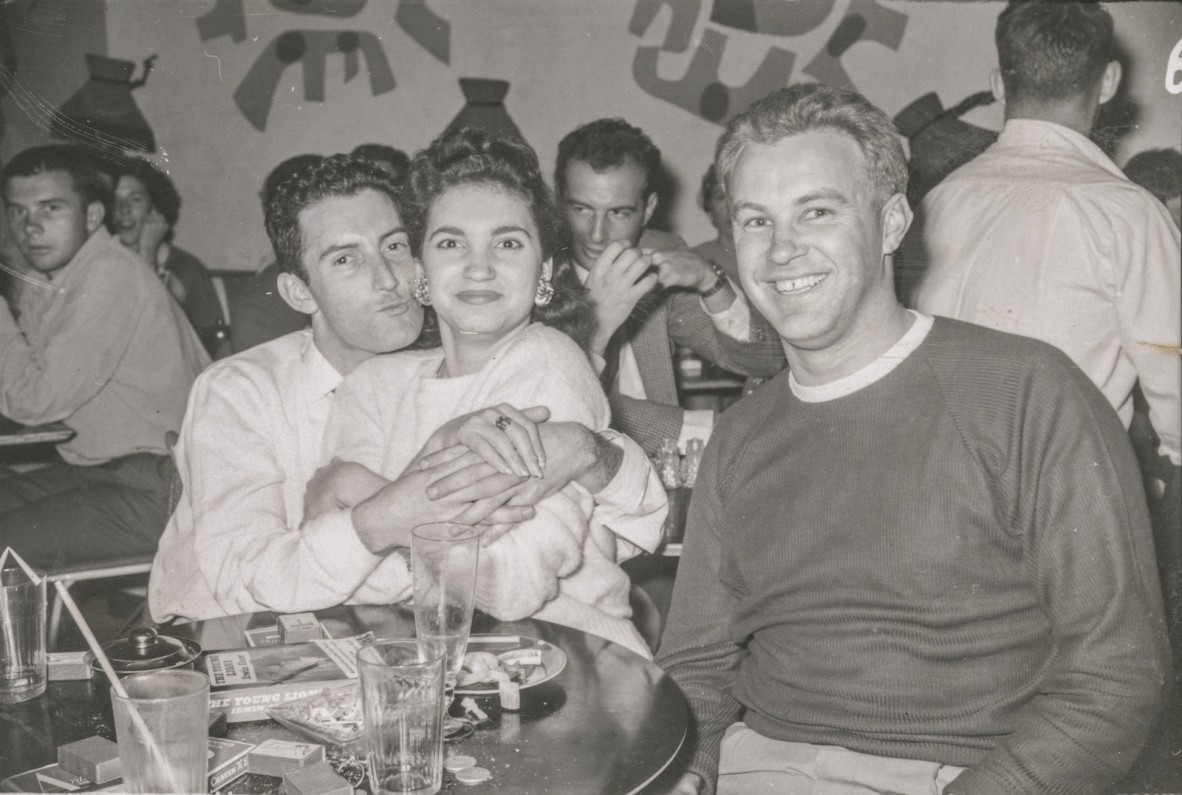
Audience members at the Primitif Coffee Lounge, Brisbane. Kevin Anderson, photographer. 32929 Peter Hackworth photographs and ephemera. John Oxley Library, State Library of Queensland. Image number: 32929-0001-0217
Her first program choice was Chet and his trio.
Chet’s story is a prime example of the new opportunities that existed for a professional musician in this period of musical transitions. Based on his online biography (The Art and Music, n.d.), Peter Clark migrated to Australia from England as a child and studied classical piano from the age of ten. At 17 he gained attention for an appearance on the radio show, Australia’s Amateur Hour and changing his name to Chet, started working professionally in Sydney in both jazz and pop groups. His first musical influences were Fats Waller, Oscar Peterson, George Shearing, and Nat Cole. Chet came to Brisbane initially to play at El Morocco nightclub, then took up his residency at The Primitif in 1957.
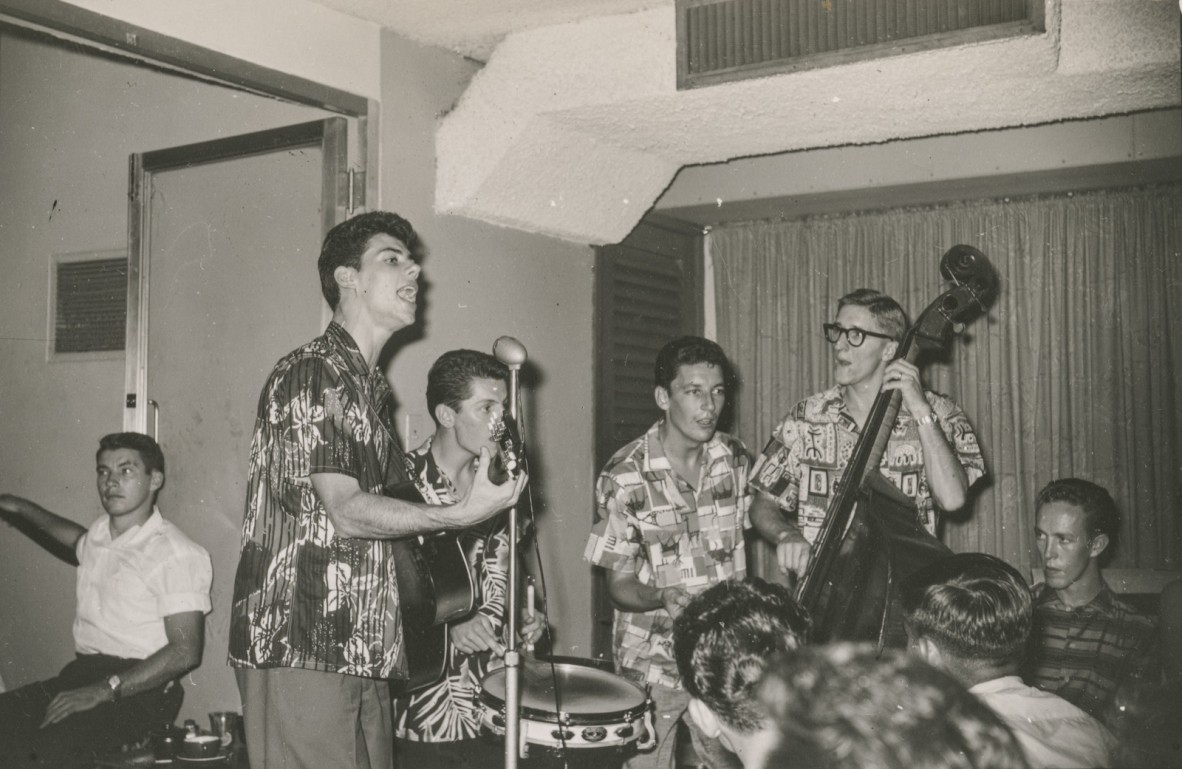
Chet Clark Trio performing at the Primitif Coffee Lounge, Brisbane. 32929, Peter Hackworth photographs and ephemera, John Oxley Library, State Library of Queensland. Image number 32929-0001-0142
Leaving The Primitif in 1959 Chet played a season at the Surfers’ Paradise Hotel and from there he moved into the Melbourne scene, writing pop tunes, singing and working on TV, hosting 6 O’Clock Rock in 1960 and 1961.
Music is an international language and Chet had the drive and talent to compete. He left Australia for the US in 1963 changing his name again, to Chet Demilo, and forging a long career as a songwriter and versatile pop and jazz musician, working on the West Coast and touring internationally. He ultimately settled in Santa Monica, running his own venue and recording his own projects (Masuda, 2021; Discogs, n.d.). Peter Clark died in 2021.
For me Buzz’s story illustrates how music enriches local communities, because music is something we can all share. Buzz was born and grew up in West End in Brisbane. In a 2003 interview he remembered the sound of radios and records in his neighbourhood,
…it was like New Orleans, because the coloured fellas weren't allowed over the bridge, and they all were there. All I ever heard growing up was music, because we used to live next to a little house of ill repute, and you could hear it was all jazz. When we went around into Thomas Street, it was all Greek music. Then we went somewhere else, it was Lebanese. When I played for the belly dancers, they said, "How do you know all these tunes?" I said, "I grew up with them”.
Buzz also talked about the role played by SJ (Sid) Bromley in sparking his vocation. SJ was a dedicated advocate for jazz in Brisbane over many decades, running clubs, presenting radio programs and informally connecting people at live events. Guitarist Rick Farbach remembered that when promoter Lee Gordon brought jazz legends Teddy Wilson and Coleman Hawkins to Brisbane, the wonderful after party was held at SJ’s modest fibro bungalow in Saint Lucia (personal communication, 2003).
Buzz told us about meeting SJ as a young bodgie. This story dates to around 1954 and is a perfect distillation of SJ’s influence on music in Brisbane.
I was knocking around with a bunch of fellas, and we went to the Old Boys Club down the Valley … They went in just to wreck the place to be a general nuisance, and that was the first time I'd heard live music…He [Sid] said, "You know what that is?" I said, "No." He said, "That's jazz." And he said to me, "You ever thought of playing music?" I said, "No." He said, "Well, think about it." And I said, "Okay." He said, "What would you like to play?" The fellow did a drum solo. I said, "I'd like to play the drums." He wrote down a name and he gave it to me and he said…"You ring this man and tell him that I said give you a go." And it turned out it was Neil Wilkinson at the Theatre Royal, in the pit in Theatre Royal. And I went down to see Neil. But things Sid said to me, he said, "You go and follow this path you're on now, in six months you wouldn't know this rubbish you walked in with".
It seems like generosity has always been a characteristic of the Brisbane music scene. Neil took Buzz on as an apprentice, never charging for lessons, and when Buzz volunteered for national service in 1955, through Neil’s connections he joined the army band, playing jazz but also learning about pipe band music, a life long love. After leaving the army and returning to Brisbane, Buzz used to congregate with others learning to play drums at Harry Lebler’s school in Woolloongabba,
… you’d go to his place on Friday night, his drum school, and all these drummers that wanted to go there would sit around in a circle. He'd throw a big parcel of fish and chips on the floor, and we'd play jazz records. And the kids would say, "Hey Harry, what is he doing there?" And Harry would get up and show you.
Buzz would take his bongos with him wherever there was a chance to sit in, earning the nickname “the drongo bummer”.

Drummer, Buzz Ennis, playing the bongos at the Primitif Coffee Lounge, Brisbane. Kevin Anderson, photographer. 32929 Peter Hackworth photographs and ephemera. John Oxley Library, State Library of Queensland. Image number: 32929-0001-0310
Buzz was also encouraged by Ricky Woodward who played with the band at La Boheme. As drinking was not permitted where there was dancing, at La Boheme the sharp end of Queensland licensing laws played out relatively often. In the case of police raids, Buzz said, “… the secret was to run out behind the bandstand, down the fire escape and out through the fruit shop in George Street. It was the escape route…” It was Ricky Woodward who introduced Buzz to Chet Clark when he was putting his trio together for the Primitif. Buzz would play at The Prim for three years.
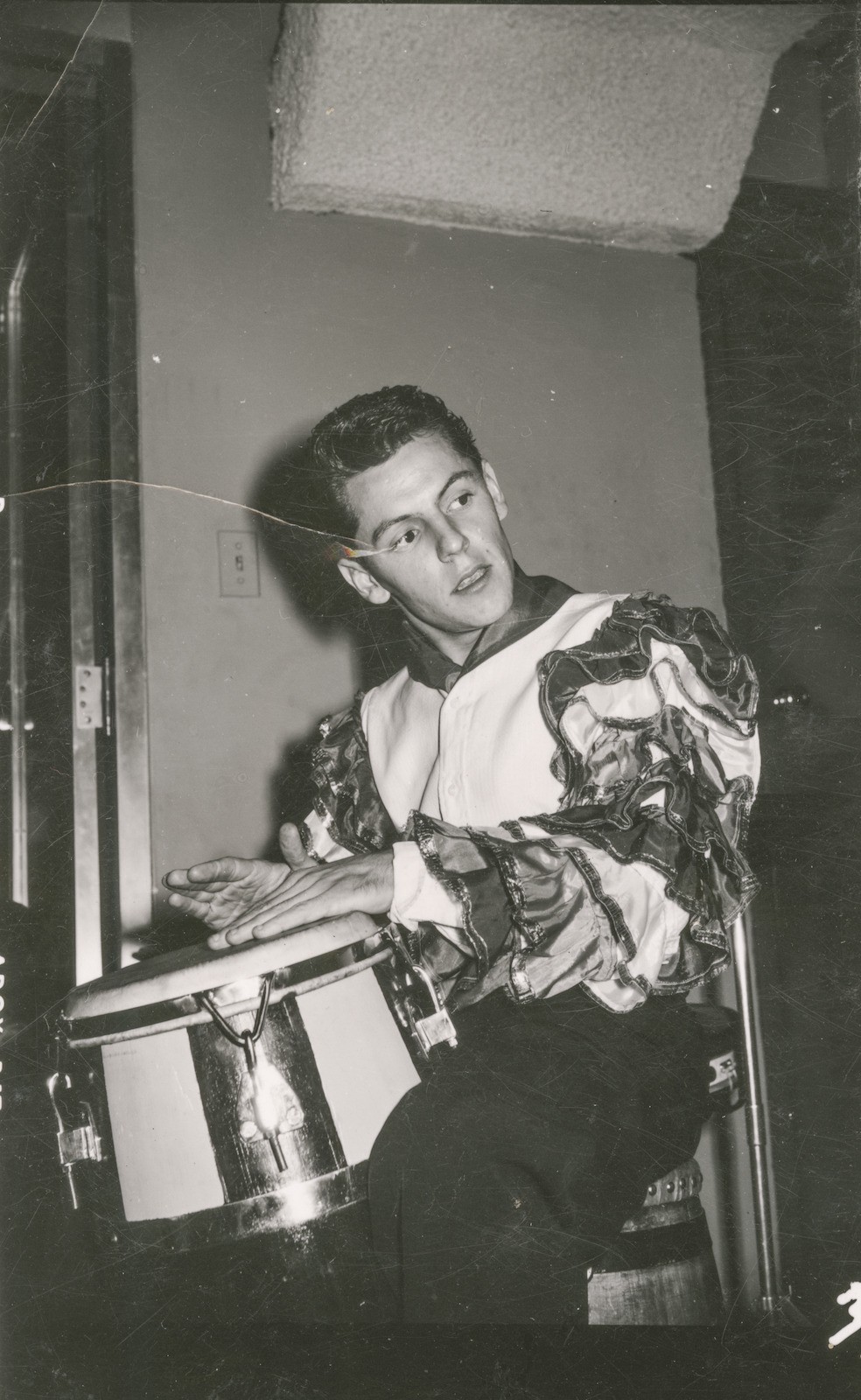
Buzz Ennis playing the drums at the Primitif Coffee Lounge, Brisbane. Kevin Anderson, photographer. 32929 Peter Hackworth photographs and ephemera. John Oxley Library, State Library of Queensland. Image number: 32929-0001-0173
Buzz has never stopped playing and teaching music. From his early musical love of Latin jazz (George Shearing and Cal Tjader) to later fusions of jazz and world beats (Herbie Mann and Spyro Gyra) with collaborator Bob Ware, Buzz was always passionate about groove and feel. In the 1990s he played rock venues with The Fabulous Nobodies. He still teaches and mentors pipe bands for free, in part, because Neil Wilkinson taught him for free. And his musical world has always been grounded in friendship. As Buzz said recently, “ I don't think I ever met anybody in jazz groups that I didn't like. They were all nice fellas. They always were wanting to find out what you were doing and how you did it …”

Buzz Ennis in 2023. Photo courtesy of Dr Leah Cottrell
For many of the musicians in the The Primitif photos, these Sunday nights are a minor footnote in a lifetime of gigs. For Chet and others who became successful entertainers, like comedian Barry Crocker and talented singers Wilma Reading and Faye Guivarra (Candy Devine), The Primitif was a brief stage in their apprenticeship. Later in the 1960s when Peter Hackworth opened “Prim Junior” upstairs in the Piccadilly Arcade, blues bands like The Purple Hearts built big followings and those nascent teenage pop stars, the Bee Gees, honed their act for the Saturday morning crowd.
But the Prim was always, perhaps more importantly, a place of community; a place where people could share, grow and learn. And because Peter Hackworth was always looking for something different and new, it was a place where musicians were invited to experiment. The music was her way of staking out a space for creative freedom, and that’s why I think jazz was the beating heart of The Primitif.
Dr Leah Cotterell was award the 2022 Letty Katts Fellowship for her project, Sunday Nights at the Primitif.
Notes
[1] The Ritz Ballroom is significant to research about The Primitif musicians because this was where newcomer Wilma Reading made her professional debut under the auspices of Hungarian band leader Lali Hegyi with his 17 piece band (personal communication, February 16, 2015). Wilma went on to have a long and successful international career and in 2023 was interviewed by State Library of Queensland for their Elders Program
References
- Australian Concert Tours 1950–1979 (2022, August) australianrecordlabels.com
- Bentley, D. (1960, December) Brisbane Bandwagon, Australian Music Maker p.48
- Bentley, D. (1961, March) Brisbane Bandwagon, Australian Music Maker p.41
- Bentley, D. (1961, September) Tropicana, Australian Music Maker p.39
- Ennis, C.B. & Sutton, B. (2003). Oral history interview with Helen Russell
- Farbach, R. (2003). Oral history interview with Helen Russell
- The Art and Music of Peter Clark (n.d.). Biography
More reading
- The Primitif Coffee Shop: young, hip and gorgeous in 1950s Brisbane
- Peter Hackworth and The Primitif: An origins story
- Rick Farbach: Riding a musical wave from Riga to Surfers Paradise
- From satin gowns to jazz advocacy – remembering Paula Langlands
- Research Reveals 2024
- Loving Lloyd : A brief biography of Lloyd Adamson (b.1929 Bryon Bay, d.1975 Sydney)
Comments
Your email address will not be published.
We welcome relevant, respectful comments.